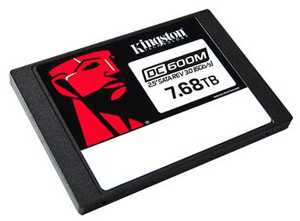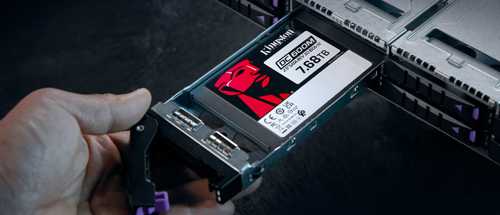Kingston Digital DC600M 2.5-Inch 6Gb SATA Up to 7,680GB Data Center SSD with 3D TLC NAND
Up to 560MB/s and 530MB/s RW speeds and 94,000/34,000 IO/s for 7,680GB model
This is a Press Release edited by StorageNewsletter.com on May 15, 2023 at 2:02 pmKingston Digital, Inc., flash memory affiliate of Kingston Technology Company, Inc., announced the DC600M Enterprise SSD.
DC600M is optimized for mixed-use workloads with QoS (1) to ensure latency and IO/s consistency to hit LLAs.
It is a 6Gb SATA 3.0 storage with 3D TLC NAND, for use in high-volume rackmount servers. The drive includes hardware based on-board power loss protection via power loss capacitors to protect data vs. unexpected power failure reducing the risk of data loss, and ensures the drive successfully re-initializes on the next system power-up. With predictable low latencies over a wide range of RW workloads DC600M is designed for system integrators, hyperscale data centers, and cloud service providers.
“QoS in an enterprise SSD is critical as data centers and workloads demand stability and low latency for predictable storage performance levels to meet strict customer SLAs,” said Keith Schimmenti, manager, enterprise SSD business. “In addition, DC600M is AES 256-bit encrypted making it the optimal data center storage solution when you combine its enterprise-class reliability and strict QoS requirements along with Kingston’s legendary sales support.”
The DC600M data center SSD is available in 480, 960, 1,920, 3,840, and 7,680GB (2) capacities.
DC600M Data Center SSD features and specs:
- Hardware-based PLP: Power loss capacitors to protect user data against unexpected power loss and enhance performance.
- Delivers excellent QoS (1): Optimized performance predictability to hit SLAs.
- AES 256-bit encryption: Built in protection to safeguard important data.
- Capacities up to 7,680GB (2): Upgrade and manage storage with capacities up to 7,680GB.
- Form factor: 2.5 Inch
- Interface: SATA Rev. 3.0 (6Gb) – with backwards compatibility to SATA Rev. 2.0 (3Gb)
- Capacities (2): 480, 960, 1,920, 3,840, 7,680GB
- NAND: 3D TLC
- Sequential RW:
- 480GB – 560MB/s/470MB/s
- 960GB – 560MB/s/530MB/s
- 1,920GB – 560MB/s/530MB/s
- 3,840GB – 560MB/s/530MB/s
- 7,680GB – 560MB/s/530MB/s
- Steady State 4k random RW:
- 480GB – 94,000/41,000 IO/s
- 960GB – 94,000/65,000 IO/s
- 1,920GB – 94,000/78,000 IO/s
- 3,840GB – 94,000/59,000 IO/s
- 7,680GB – 94,000/34,000 IO/s
- QoS/Latency (3,,4,5) (99.999) RW:
- 480GB – 180/110µs
- 960GB – 3,840GB – 200/300µs
- 7,680GB – 240/170µs
- Typical latency – RW: <200µs / <30µs (3,4,5)
- Hot-plug capable
- Static and dynamic wear leveling
- Enterprise SMART tools: Reliability tracking, usage statistics, life remaining, wear leveling, temperature
- Endurance:
- 480GB – 876TBW (6), 1 DWPD (5 years) (7), 1.66 DWPD (3 years)(7)
- 960GB – 1752TBW (6), 1 DWPD (5 years) (7) 1.66 DWPD (3 years) (7)
- 1,920GB – 3,504TBW (6), 1 DWPD (5 years) (7), 1.66 DWPD (3 years) (7)
- 3,840GB – 7,008TBW (6), 1 DWPD (5 years) (7), 1.66 DWPD (3 years) (7)
- 7,680GB – 14,016TBW (6), 1 DWPD (5 years) (7), 1.66 DWPD (3 years) (7)
- Power consumption:
- Idle: 1.30W
- Average: 1.45W
- Max read: 1.6W
- Max write: 3.6W
- Storage temperature: -40°C ~ 85°C
- Operating temperature: 0°C ~ 70°C
- Dimensions: 69.9mm x 100mm x 7mm
- Weight: 92.34g
- Vibration operating: 2.17G peak (7–800Hz)
- Vibration non-operating: 20G peak (10–2000Hz)
- MTBF: 2 million hours
- UBER: ≤10 -17
- Warranty/support: Limited 5-year warranty with free technical support (8)
(1) QoS of an SSD refers to the consistency and predictability of latency (response time) and IO/s performance while servicing a read/write workload. QoS metrics demonstrate that, given a worst-case workload tested over a period of time, an SSD’s latency and IO/s profiles stay within a specified range without having unexpected outliers causing a sudden drop in application performance.
(2) Some of the listed capacity on a flash storage device is used for formatting and other functions and thus is not available for data storage. As such, the actual available capacity for data storage is less than what is listed on the products. For more information, go to Kingston’s Flash Memory Guide.
(3) Measurement taken once the workload has reached steady state but including all background activities required for normal operation and data reliability.
(4) Based on 960GB capacity.
(5) Workload based on FIO, Random Aligned 4KB QD=1 workload. QoS is measured as the time taken for 99.999 percentile of commands to finish the round-trip from host to drive and to host. Typical latency is measured as the time taken for 99.9 percentile of commands to finish the round-trip from host to drive and to host.
(6) Total Bytes Written (TBW) is derived from the JEDEC Enterprise Workload (JESD219A).
(7) Drives Writes Per Day (DWPD).
(8) 5-year conditional SSD warranty based on which of the following events occurs first: (i) 5 years from the date of purchase by the original end user customer; (ii) when the usage of a SATA SSD as measured by Kingston’s implementation of the SMART attribute 231, labeled as ‘SSD Wear Indicator’, reaches a normalized value of one as indicated by Kingston’s SSD Manager (KSM)















 Subscribe to our free daily newsletter
Subscribe to our free daily newsletter

